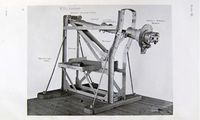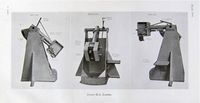Loader (equipment)
The Loader (or Loading Teacher) was a mock-up of the breech of a hand-loaded gun created around 1900[1] by Percy Scott to permit gun crews to to practice efficient loading without the concomitant wear and tear that would result by use of an actual gun and to obviate the need to withdraw the shell from the weapon after each loading cycle. Along with the Dotter, it became one of the hallmarks of Scott's transformation of Royal Navy gunnery and exemplified how his innovations were often syntheses of drill and equipment.
In addition to a gun breech, the loader had a trough in place of a barrel of such length that the shell should slide to a gentle stop at the end if it had been rammed with the proper force to engage the rifling of an actual gun. The shell would then be handed to a position where it could be taken in hand as a new shell being brought up for firing. In this way, a few inert shells would suffice to keep a crew working continually so their speed and endurance could be tested to whatever extent seemed prudent. Any other appliances particular to the gun in question would be simulated and used in the drill.[2]
In preparation for the 1901 Prize Firings, Scott's crews in Terrible could load 100 pound shells and 55 pound cartridges twenty cycles in ninety seconds.[3]
British 6-in BL Loaders
- 6-in BL Loaders
The Royal Navy had at least three models of loaders for 6-in breech-loading guns. In the 6-in BL Loader Type A, a trough represented the chamber of the gun. A dummy breech was fitted, and shells rammed home would meet a cushion, from which they would roll aside into a receiving tray from which sailors would reclaim it and re-position it as a new shell for the loaders to use. The 6-in BL Loader Type B was similar, but sat on stools to give it 5° of elevation to better mimic later model 6-in guns.
The 6-in BL Loader Type C was adjustable in elevation in 5 degree increments from horizontal to 20°
British 4-in and 4.7-in Loaders
These were similar to the 6-in Type C.[4]
British 3-in High Angle Loader
The High Angle Loader was a tube fitted with trunnions that could be adjusted over a wide range of elevation angles. Loading HA guns was especially difficult work when working at high elevation angles, despite the relatively modest shell weights involved.
Other Arrangements
Larger guns and the Vickers semi-automatic 4-inch gun had wooden shells (sometimes wrapped in cowhide to protect the rifling) and dummy cartridges for practice use at the guns.[5]
See Also
Footnotes
Bibliography
- Peter Padfield (1966). Aim Straight: A biography of Sir Percy Scott, the father of modern naval gunnery. London: Hodder and Stoughton. (on Bookfinder.com).





